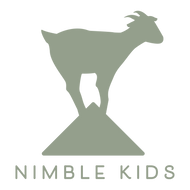Exploring Pikler Triangles & Montessori with Habitat Early Learning’s Smeeta Vanmali

At Nimble Kids, we love Pikler triangles and all the development opportunities and incredible play potential they deliver. We spoke to Smeeta Vanmali, Montessori Advisor at Habitat Early Learning to understand more about how the Nimble Kids Pikler triangle climbing frame supports the development of our littlest learners.
For those who might be new to Montessori, it’s an approach to education that aims to encourage a lifelong love of learning by following their own natural development path. Children are supported to become confident, independent, respectful learners, growing at their own pace
“Children are so eager,” Smeeta says. “They're so hungry to learn, and what we want to do is to keep that inner flame burning.”
Pikler triangle: an ideal Montessori toy for babies and toddlers
The Pikler triangle is an open-ended toy designed for children of all ages, from babies through to toddlerhood and beyond. At Habitat Early Learning, toys like the Pikler triangle are introduced early in the education journey.
“Birth to three is what we call a ‘sensitive period’ in Montessori,” Smeeta explains. “During this time movement is a key focus, with children developing their gross motor skills to pull themselves up, crawl, and eventually walk unassisted.”
The Pikler triangle presents a range of gross motor challenges for children to accomplish. “You’re getting so many different developmental learning outcomes from a Pikler triangle. It’s also giving the child freedom of choice in how they use it.”

Developing Gross Motor Skills & Coordination
Climbing is one of the best activities to develop gross motor skills. And even better – it’s fun. The Pikler triangle supports movement for very young children in a range of ways. Here’s a few:
- Babies can use their upper body strength and core muscles to pull themselves up to standing
- Babies and pre-walkers can practise balancing and moving their bodies in a standing position using the support of the rungs
- Toddlers can work on strengthening their upper and lower bodies and core through climbing and manoeuvring themselves over the top of the frame
- Older toddlers and children can practise their cross-body movements and coordination as they climb, moving left and right sides independently
Younger babies who aren’t yet crawling or standing can also learn to use their body to reach, grasp and manipulate the rungs and pieces of the climbing frame. Hanging noisy items like bells or rattles from the rungs can encourage babies to kick, with the sound helping them to understand how they can move their body and introducing cause and effect.

Language Development
We often think of climbing frames as providing a wealth of physical development opportunities, however like most Montessori toys, there’s more than meets the eye. Smeeta also encourages parents to use the Pikler triangle to build on language skills.
“Name the colours, talk about the length of the equipment, its weight and resistance to movement, and start counting the rungs as they climb. These all help in language development for your child.”
Independence & Heavy Work
The benefits of the Pikler triangle start even before the child begins to play.
“With older children, allow them to decide how you’re going to set it up, particularly with the extensions,” Smeeta says. “Giving them choice allows them the freedom to explore that piece of equipment and autonomy over their space.”
It also presents an opportunity for heavy work, which targets the proprioceptive system – the understanding of where their body is in the environment, how they move it and the level of force needed to interact with objects. Pulling, pushing and lifting the Pikler triangle and accessories as they set it up all provide a wonderful opportunity for children to safely engage in heavy work.
“With our under threes at Habitat, they love that maximum lift. We often see children seeking heavy work by pushing chairs and manoeuvring furniture. The Pikler triangle can give them opportunities to do things like that, by involving them in setting up or packing away part of their prepared environment.. Moving it gives them the opportunity to understand weight, size, and how to manipulate a piece of equipment, which helps build spatial awareness.”

The Importance of Supervised Risk
One thing Smeeta is keen to remind parents is to be the support person, scaffolding your child’s learning, rather than being too hands-on or directing the play.
“Don’t jump in too quickly,” she cautions. “A young child, as young as one or under, can communicate if they need help, by simple facial expressions, a grunt or sound.
“As educators at Habitat, we sit and observe each child to see how they interact with equipment like the Pikler triangle. By watching how they interact, we learn ‘okay, this is an area we need to support them’ – whether that’s confidence to climb, balance or even problem-solving how to use the toy alongside another child.”
Play is the Work of a Child
As Maria Montessori said, play is the work of the child. As parents, it’s our responsibility to provide them with engaging, interesting and challenging toys to support them to do their best ‘work’.
“We want to keep that intrinsic motivation and love of learning going, because they've got their whole life to learn and if they love it from now, if they're involved and they can see the results of their effort, they're going to keep going.”
About Habitat Early Learning
Habitat Early Learning is a leading early learning service, with centres in Ferny Grove, Nundah and Peregian Springs. Each service offers dedicated Montessori classrooms for all ages under the guidance of experienced Montessori Advisor, Smeeta Vanmali. Habitat instils children with curiosity, confidence and sense of self that guides them long into the future. Learn more about Habitat Early Learning



















